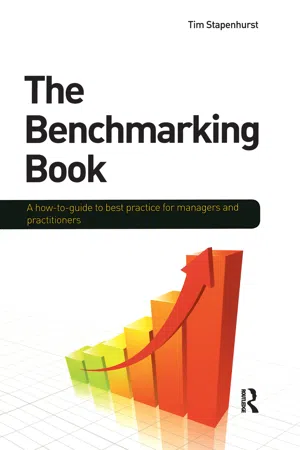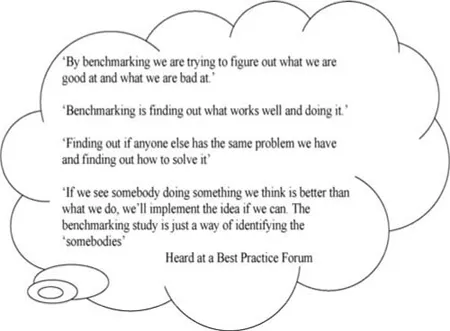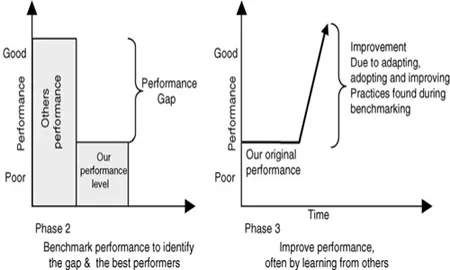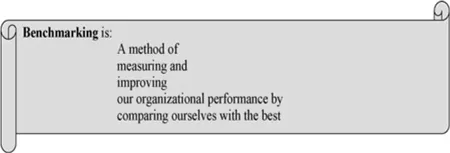![]()
A Background to BM
INTRODUCTION
In Part 1 of this book we aim to provide a backdrop for the rest of the book which deals with the practice of benchmarking.
The first question to answer is what exactly is benchmarking? In Chapter 1 we explore different ideas of benchmarking as proposed by those who have developed and used it. To help clarify what benchmarking is, we also look at some practices that are not benchmarking.
Benchmarking developed as a solution to a problem. Though practices akin to it had been around for many years, it is Xerox that we have to thank for formalizing it and developing it into a crucial performance improvement tool. It is appropriate, therefore, to include a description of how benchmarking enabled Xerox not only to survive but to become a market leader in a competitive market during the 1970s.
Benchmarking has moved on over the last 40 years and there are now many reasons why organizations benchmark, and many benefits that they gain. Performance improvement, budgeting, testing ideas, technical problem solving and resolving disputes are just a few of the reasons why organizations benchmark today.
There has been a surge in interest in Six Sigma and other improvement methodologies in the last few years. The connection between these and benchmarking is highlighted at the end of Chapter 1 and shows that they are closely related. Indeed, it has been said that benchmarking is a short cut improvement process as it identifies best practices without us having to try to invent them ourselves.
Many books on benchmarking propose one specific process. That is a shame, for in reality the benchmarking process that an organization uses needs to suit the specific objectives of the project. When writing this book I realized that the only way to keep the size of the book within reasonable limits was to follow the same path of focusing on one specific, albeit generic process. However, akey message throughout the book is that there is no one right way to benchmark. To highlight this fact Chapter 2 overviews several different methods of benchmarking, and acknowledges that there are almost endless variations. Despite the very different types of benchmarking the process of each can be seen to be a special case of a generic process which is explained in detail in Part 2 of the book.
![]()
What is Benchmarking?
The chances are that if someone is able to do what you are doing better, faster and/or cheaper, they have different practices than you have. Discovering what those practices are, adapting them to your situation and adopting them is very likely to improve your performance.
INTRODUCTION
How do we define ‘benchmarking’ ? What are its origins? Why do organizations benchmark? What benefits does it bring? What can I benchmark? How does benchmarking relate to Six Sigma and process improvement?
These are typical questions that people first ask when they become aware of benchmarking and all of them are addressed in this chapter. There is also a brief summary of how and why Xerox developed and used benchmarking as a key survival tool in the face of fierce Japanese competition.
This chapter also explains the two aspects common to many benchmarking studies:
1. Comparison of performance levels to ascertain which organization(s) is achieving superior performance levels.
2. Identification, adaptation/improvement, and adoption of the practices that lead to these superior levels of performance.
1.1 WHAT IS BENCHMARKING?
Developing a single all-embracing definition of benchmarking is not easy. It is commonly applied to a wide variety of activities that organizations undertake to compare their performance levels with others and/or identify, adapt, and adopt practices that they believe will improve their performance. Before presenting the definition of benchmarking that forms the backdrop of the book, let us look at some of the things that those involved in benchmarking have said of it.
For some, benchmarking needs only to involve the comparison of performance metrics, and needs not include an element of process improvement. This would certainly be the case for the organization with the best performance levels.
For some people, benchmarking is a continuous process rather than a one-off process.
This definition specifically highlights that benchmarking can apply to the products, services, and practices of an organization. More broadly, benchmarking can be applied to any area where we want to compare performance and/or learn from others. The definition also specifies that we want to benchmark against either our toughest competitors, so that we know where our strengths and weaknesses are in relation to them, or industry leaders so that we are aware of the highest performance levels currently being achieved.
Some consider benchmarking as the comparison of practices, while for others, and perhaps most commonly, it includes both the comparison of performance and practices.
Notice that these four comments on benchmarking do not focus on the method, only on the required end result.
One interesting definition from Roger Milliken is:
Benchmarking definitely is not stealing, at least not without permission! But it may entail adopting and adapting ideas, practices or methods, with permission, from other benchmarking participants.
As these definitions and quotes illustrate, there are different ways to view benchmarking. In this book we take the view that benchmarking consists of two basic phases (Figure 1.1): (phase 1 is a preparation phase)
FIGURE 1.1 Two phases of benchmarking.
1. Benchmarking performance (i.e. data) to:
- quantify performance levels of different participants,
- identify the gap between participants, often between the best performer(s)
and other participants,
in order to:
- quantify the potential gain for each participant to operate at the level of the best performer(s).
2. Changing our practices to improve our performance, possibly, but not necessarily by learning from other participants (
Chapter 17).
From the above discussion we can produce a useful and comprehensive definition of benchmarking that applies to many benchmarking projects:
In Part 2 of this book we focus on the comparison of metrics and a variety of improvement activities, including methods of sharing practices. We acknowledge the many other reasons for, as well as methods and ideas of benchmarking by including case studies, discussions, and examples that do not adhere to this definition.
1.2 … AND WHAT BENCHMARKING IS NOT
If statistics is the art of manipulating data to tell the boss what he wants to hear, then perhaps benchmarking is the art of comparing your organization’s performance with other carefully selected organizations to ensure that the conclusion is what you wanted it to be before you started benchmarking. That would, of course, be a misuse of benchmarking and statistics, but sometimes it seems that these are the aims.
In order to clarify what benchmarking is, it helps to consider what benchmarking is not. Benchmarking:
Is NOT industrial tourism whereby companies visit one another, enjoy a day out, or even a trip half way around the world but no objective comparison or analysis takes place. Such activities lead to benchmarking being seen as irrelevant and a perk for the favoured few. However:
it IS planned research with a high return on investment.
Is NOT a staff appraisal tool. This will lead to resistance to benchmarking by falsifying data, delaying the project, or discrediting the study (
The result of using benchmarking as an appraisal tool Chapter 20). However:
it IS helpful to identify where and how to improve the processes.
It is NOT a copy and paste activity. Copying what someone else has done in their organization and expecting it to work assumes:
- that your organization has a similar culture, a similar operational environment, and similar issues as the one from which you are copying (
Chapter 19);
- that the organization you are copying from has the optimum solution.
However:
It IS a potential source of ideas, information, methods, practices, etc. that it may be appropriate to adapt, adopt, and implement.
Is
NOT a one-off event. At best this will lead to achieving a competitive edge today, but that is likely ...
















